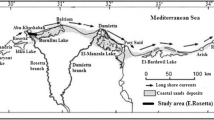Summary and Conclusion
The beach sands of the Vizagapatam coast between Yarada village and Rushikonda, covering a distance of about ten miles have been taken up for detailed study by sedimentary petrographic methods. Six representative samples from the collection, three of white sands and three of black sands, were subjected to mechanical, heavy mineral, and magnetic separation and the products thus obtained gravimetrically and optically estimated. It is found that of the heavy mineral suite, magnetites are most abundant, followed by monazite, garnet, sillimanite, zircon and ilmenite. At least about 2% of the black sand concentrate consists of monazite. Excluding +60 mesh material, monazite is found to be 8% of the bulk of black sands. Though the white sands invariably yield monazite, their quantity is proportionately insignificant. Further investigations are in progress.
Similar content being viewed by others
References
Tipper, G. H. “The Monazite Sands of Tranvancore,”Rec. Geol. Surv. Ind., 1914,44, Part 3, 195.
Viswanadhan, P. “Beach Minerals of Travancore,”Science and Culture, 1946,12, No. 1, 22–29.
Author information
Authors and Affiliations
Rights and permissions
About this article
Cite this article
Mahadevan, C., Sriramadas, A. Monazite in the beach sands of Vizagapatam district. Proc. Indian Acad. Sci. 27, 275 (1948). https://doi.org/10.1007/BF03171016
Received:
DOI: https://doi.org/10.1007/BF03171016




